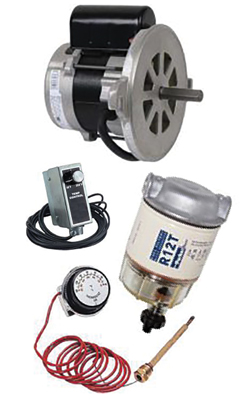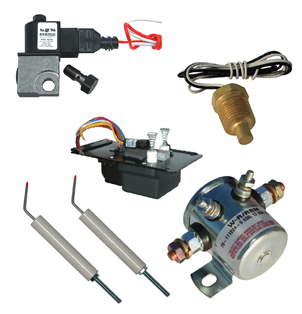
Safety First! Troubleshooting the Challenging Burner
By Dan Galvin / Published June 2022

One thing about the power washing community—we’re here to help one another. We’re quick to share our expertise and lessons learned. Whether you’re new to the industry or you’ve got some mileage on your truck, you will at some point need advice regarding burner troubleshooting.
Once trouble happens, most people open up the burner, see all those wires, close it, and then say, “I need to call somebody.” At EnviroSpec, calls for advice regarding burner problems are probably our number one request on the help line.
Most of the hot water pressure washers in the U.S. use either a Beckett or a Wayne burner, and that’s what this article will focus on.
Like the high-pressure pump, burners have been around for ages, and with proper maintenance you should get a long life out of it. In my experience, most problems with burners that customers have involve a failure of a related system component that controls the burner.
Burners can be very dangerous, causing fires and steam explosions. Because of this, there are safety features built into the pressure washers. However, often it’s one of these safety features that’s causing problems with your burner. Before your burner can even ignite, the power will have to go through a pressure/flow switch, the thermostat, and on some units, a high-limit switch.
Troublemakers
Problem—Pressure Switch
The pressure switch, which is usually located on the high-pressure pump head, gets top billing as the number one safety feature and component-related problem causing the burner not to ignite. If your burner suddenly stops working, look at the pressure switch first. If you turned your pressure washer on and the burner doesn’t turn on, make sure your thermostat is on. Learn from my mistake! I wasted about three hours tearing my pressure washer apart trying to get the burner to work only to find out my thermostat was off. Ugh!
When I was out in the field and needed my burner to work, I would bypass the switch to see if that was the problem. With the pressure washer off, I would remove the inspection plate on the pressure switch and jump the wires (usually the red and brown wires) inside the pressure switch. Then I’d turn the pressure washer on to see if the burner worked. If it worked, I’d replace the pressure switch. Problem solved.
 I can never emphasize the need for safety enough. DO NOT USE the pressure washer with the pressure switch bypassed; the burner will not turn off, and the coil could explode!
I can never emphasize the need for safety enough. DO NOT USE the pressure washer with the pressure switch bypassed; the burner will not turn off, and the coil could explode!
Alternatively, you could use a multimeter to check the pressure switch as well. With the pressure washer running, use a multimeter to check if you have voltage on the switch as you open the trigger gun. With the pressure washer off, check to see if the switch is working by using a small flathead screwdriver to lift the microswitch button and test the ohms.
Problem: No Power to the Burner
Sometimes the problem is that there’s no power to the burner. A couple of quick checks and/or tests are called for.
- Check the wiring for loose or shorted connections; then repair or replace as needed.
- Check for an open fuse or circuit break and replace as needed.
- Test the power on/off switch. Use a meter to check if there is power to both sides of the switch when the switch is on. If you don’t have power to both sides, replace the switch. If you don’t have a meter, jump/bypass the power switch. Then if the power is restored, replace the switch.
- 12-volt burner—Test the battery and engine charging system to determine if the burner is receiving sufficient incoming voltage and repair or replace as needed. What follows is a problem that many contractors get themselves into: The engine battery recharging system when using the ADC burner must be at least 18 amps, and for the SDC burner the re-charging system must be at least 25 amps. If it’s anything less, not only will your burner be smoking most of the time, but you’ll be destroying many of the workings of the burner simply because you are not supplying enough power to it.
- 115-volt burner—Test the generator to determine if it is producing sufficient voltage and repair or replace as needed.
Problem: No Fuel to the Burner
Assuming the safety components are working properly, here are some troubleshooting questions to ask.
- Is there fuel in the tank? If so, then check the fuel lines and make sure the hose clamps are tight and no air is getting in. Also check the fuel filter for a clog or restriction, and check for cracks or leaks on the filter.
- Is the fuel nozzle clogged? If so, replace the fuel nozzle.
- Is the fuel getting to the pump? If not, open the bleeder valve and check for fuel.
- Is the fuel pump turning? If not, the drive coupling may be broken and needs to be replaced.
Problem: No Spark Igniter/Transformer
Most 115-volt burners have a transformer; some have an igniter. All 12-volt systems have an igniter. Both are tested using the same method.
With the system off, remove the screws that secure the top of the mounting plate to the burner housing and open the transformer/igniter on its hinge. You’ll see two spring-looking contacts. Use an igniter/transformer tester to make testing quick and easy.
With power going to the igniter/transformer, touch the high voltage spheres of the tester to the contacts of any brand of igniter or transformer. If the green LED
lights up, the unit is good.
Caution: Igniter/transformers have approximately 10,000 volts that jump the gap between the ignition electrodes. DO NOT use a large screwdriver with an insulated grip to check for arcing between the igniter/transformer contacts; always use the proper test equipment or hire a professional.
Burners are probably one of the most challenging pieces of equipment you’ll own. While troubleshooting advice is great for the DYI type, it’s no substitute for knowing when the safety factors outweigh a burning curiosity to fix it yourself. You can Power
Through!™ most of your troubleshooting issues, but as always, safety first!
Dan Galvin is EnviroSpec’s president and CEO and has worked in the power washing industry for 20 years. If you have more questions for Dan, contact him at (800) 346-4876 or visit www.envirospec.com.







